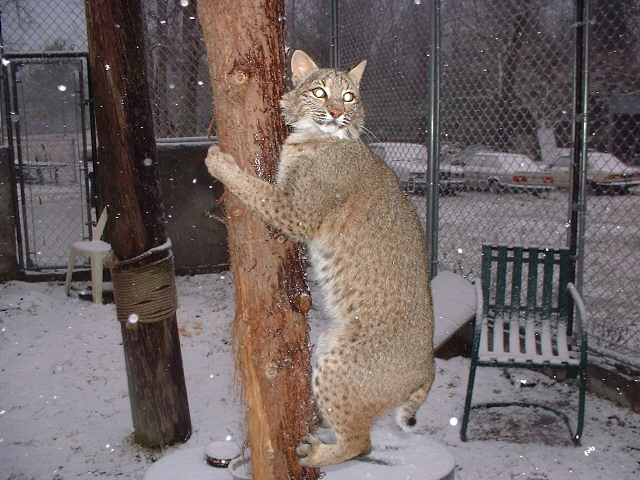
Profile by Phil Crosby
Bobcat (aka - red lynx, bay lynx)
Lynx rufus
 |
| The Scottish Big Cats mascot, Exmoor, the Bobcat |
|---|
The Lynx is a distinctive looking cat, which is readily identified by its short tail. There are four species, the Eurasian Lynx (Lynx lynx), the Canadian Lynx (Lynx canadensis),the Iberian Lynx (Lynx pardinus) and the Bobcat or Red Lynx (Lynx rufus). Of these the Eurasian was resident in Britain until historic times (and some believe it may never have become completely extinct), the Canadian is a cat which may have been released into the wild either accidentally or deliberately. The Iberian Lynx is perhaps the rarest big cat species in the world, numbering fewer than 500 in the wild, and as such is unlikely to be encountered in the UK.
The bobcat is a member of the lynx family and owes its name to its characteristic stumpy tail. The Scottish Big Cats mascot, Exmoor, is a fine example of a bobcat, having been raised since a kitten by Ben Willis.
Life span
Bobcats can live for 12-13 years in the wild and up to 25 years in captivity.
Statistics
Body length: 62-95 cm, Tail length: 13-20 cm, Shoulder height: 50-60 cm, Weight: male: 8.9-13.3 kg, female: 5.8-9.2 kg.
Physical Description
Bobcats have light grey to yellowish-brown or reddish-brown fur with white undersides. They have short ear tufts, cheek ruffs and a dark tip to their characteristic stumpy tail. They sometimes have spots or tabby stripes. Bobcats are heavily-built cats.
Distribution
They are found from the Canadian/USA border down to Mexico. Where Canada lynx and bobcats meet, the more aggressive bobcat tends to displace the lynx. But bobcats have shorter legs and smaller paws than the lynx, and so are less able to colonise areas of deep snow.
Habitat
They live in forests in the north, swamps around Florida, and desert and scrubland in south-west areas of US. They are absent from highly cultivated areas of the northern mid-states.
Diet
Bobcats in the south typically hunt cottontail rabbits and populations in the north hunt snowshoe hares, but they adapt according to availability. Males will hunt larger animals, such as deer, when food is scarce. Rodents, bats and birds are also prey items.
Behaviour
Bobcats are solitary except during the mating season. They are secretive and are most active around dusk and dawn. They rely on vision and hearing to detect prey. Male territories are 2-3 times larger than females. Male ranges overlap many female territories and also may overlap with other males. Females will not overlap with other females ranges.
 |
 |
 |
| Return to index | Return to Scottish Big Cats | Return to Identification |